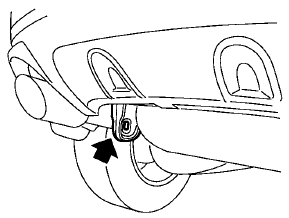Vehicle recovery (freeing a stuck vehicle)

Tie down and recovery hook
WARNING
• Stand clear of a stuck vehicle.
• Do not spin your tires at high speed.
This could cause them to explode and result in serious injury. Parts of your vehicle could also overheat and be damaged.
Pulling a stuck vehicle
If your vehicle is stuck in sand, snow, mud, etc., use a tow strap or other device designed specifically for vehicle recovery. Always follow the manufacturer’s instructions for the recovery device.
Front:
Securely install the vehicle recovery hook (stored in the cargo area) as illustrated. Make sure that the hook is properly secured in the original place after use.
CAUTION
• Tow chains or cables must be
attached
only to the main structural
members of the vehicle or the
recovery hook. Otherwise, the vehicle
body will be damaged.
• Never tow a vehicle using the vehicle
tie downs or recovery hooks.
• Always pull the cable straight out
from the front of the vehicle. Never
pull on the vehicle at an angle.
• Pulling devices should be routed so
they do not touch any part of the
suspension, steering, brake or cooling
systems.
• Pulling devices such as ropes or
canvas straps are not recommended
for use in vehicle towing or recovery.
Rocking a stuck vehicle
If your vehicle is stuck in sand, snow, mud, etc., use the following procedure:
1. Turn off the Vehicle Dynamic Control (VDC)
system.
2. Make sure the area in front and behind the
vehicle is clear of obstructions.
3. Turn the steering wheel right and left to clear
an area around the front tires.
4. Slowly rock the vehicle forward and backward.
• Shift back and forth between R
(Reverse)
and D (Drive).
• Apply the accelerator as little as
possible
to maintain the rocking motion.
• Release the accelerator pedal
before
shifting between R and D.
• Do not spin the tires above 35 MPH
(55
km/h).
5. If the vehicle cannot be freed after a few tries, contact a professional towing service to remove the vehicle.
See also:
HomeLink® universal transceiver (Type A) (if so equipped)
The Type A system does not have an IV 1 on the
back of the mirror. Move the mirror to see if the IV
is present. If the IV is not on the mirror, use the
procedure in this section to program the
H ...
Towing safety
Trailer hitch
Your vehicle may be equipped with an optional
trailer tow package. The trailer tow package includes
a receiver-type frame mounted hitch. This
hitch is rated for the maximum towing ca ...
Engine oil and oil filter recommendation
1. API certification mark
2. API service symbol
Selecting the correct oil
It is essential to choose the correct grade,
quality, and viscosity engine oil to ensure
satisfactory engine life and p ...
